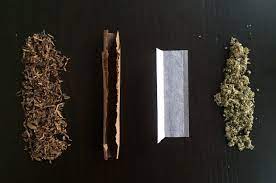What’s the difference between joints, blunts, and spliffs?

Joints are arguably the most popular way to consume weed. It’s easy to put one in your pocket, spark it up wherever, and pass it around with friends. Rolling is a skill that any seasoned stoner should learn over time, and one that may be elusive for novices.
There are other ways to roll up weed too, namely, into blunts and spliffs. These three different rolls all have nuances, involving different amounts of cannabis and tobacco.
Defining joints, spliffs, and blunts
Joints, spliffs, and blunts, can be defined by how much cannabis and tobacco they have and what material is used to roll them.
Joint and spliffs are both rolled with rolling papers. A joint’s filling is all weed; a spliff is basically a joint with tobacco mixed in with the weed.
Blunts are rolled using wraps, and wraps are made of tobacco. The filling of a blunt typically doesn’t contain tobacco, just the wrap.
Comparing weed joints, spliffs, and blunts at a glance
| Contains cannabis | Contains tobacco | Uses rolling paper | Uses wrap | |
| Joints | Yes | No | Yes | No |
| Spliffs | Yes | Yes | Yes | No |
| Blunts | Yes | Yes | No | Yes |
What is a joint?
Perhaps the most iconic way to consume cannabis, joints are small and portable, and you can take them anywhere and spark up.
They consist of cannabis rolled up inside a thin rolling paper that is usually white, but novelty papers come in all colors and even different flavors. Papers can be big, small, or medium—common sizes are singles, 1 ¼, 1 ½, wide, and king, and they can come in thin, ultra thin, wide, and other sizes and types.
Rolling papers can also be infused with flavors such as grape, cherry, chocolate, and more, and can be made out of hemp, rice, paper, flax, and more. There are all kinds of variants.
Joints often have a crutch, or filter, at the drawing end, which adds stability to the roll and allows you to smoke a joint to the end without burning your fingertips.
What is a spliff?
A spliff is made with a rolling paper like a joint, but the filling has tobacco and cannabis mixed together. Spliffs usually have more tobacco than a blunt, so they will have even more of the energetic, buzzy effects of tobacco. Spliffs usually have crutches like joints.
Spliff smokers can adjust the ratio of cannabis and tobacco to their preference—lots of cannabis with a little tobacco, lots of tobacco with a little cannabis, or somewhere in between.
What is a blunt?
A blunt is a roll of cannabis inside a cigar or blunt wrap. These wraps are made out of tobacco, which adds a buzz and energy to your cannabis high. Typically, they’re bigger than joints and spliffs and last a lot longer.
Blunt wraps are often sold at corner or grocery stores and come in 1- and 2-packs. They are often flavored. You can also cut open a cigar, empty it, and use the wrapping for a blunt. Cigarillos, such as a Swisher Sweets, Phillies, or Dark & Milds, are also great for blunts.
Differences in rolling papers and wrappers
Rolling material choice is important to the smoking experience. You’ll want the correct size and material of paper for the amount of weed you want to roll and the number of people in your smoking circle.
Here are types of papers used for each:
- Joint: singles, 1 ¼, 1½, wide, king, slims or thins, cones
- Spliffs: 1½, wide, king, cones (often larger than joints because of tobacco)
- Blunts: Wraps, cut-open cigars
If smoking by yourself or with a friend, a single or 1 ¼ may be fine. If smoking with a big group, you may want some king size papers.
Different thicknesses will also affect your smoking experience—thick papers tend to burn slower than thin papers, but you won’t taste the paper as much with thins.
Both rolling papers and blunt wraps can be flavored, but they aren’t for everyone. Some smokers think flavored papers meddle with the flavors and aromas of cannabis, while others are loyal to specific brands because of their distinct flavor additives, something more common among blunt aficionados.
Consumers also choose papers based on rolling ease and functionality. The best papers don’t tear, seal easily, handle well between the fingers, and burn uniformly. Nobody likes a joint that runs, or burns lengthwise along one side. Some papers even have corners cut off for easy rolling.
Joint vs. blunts vs. spliffs: Which is best?
There are pluses and minuses to each consumption method, and why someone would choose one method over another can also depend on preference.
Pros and cons of joints
Joints have remained a mainstay of cannabis consumption for a long time for a reason.
Pros
- Small and portable
- Easy to spark up
- Great for sharing
- Easy to put out and save for later
Cons
- Takes experience to learn to roll one properly
- Not very discreet (others in the area will know you are smoking a joint)
Pros and cons of spliffs
Spliffs are like joints but with tobacco as well. They have many of the same pros and cons as joints.
Pros
- Small and portable
- Easy to spark up
- Great for sharing
- Tobacco adds a buzzy, energetic feeling
- More discreet than a joint—people may think you’re smoking a cigarette
Cons
- Smoking tobacco can be harmful to your health
- Tobacco can ruin the taste of weed
- Takes experience to learn to roll one properly
Pros and cons of blunts
Blunts have diehard fans. Some people only smoke blunts, but others save them for special occasions.
Pros
- Portable
- Easy to spark up
- Great for sharing
- Tobacco adds a buzzy, energetic feel
- Come in a variety of flavors
Cons
- Smoking tobacco can be harmful to your health
- Tobacco can ruin the taste of weed
- Often flavored—this can be a negative for some
- Takes experience to learn to roll one properly
Global preferences for joints, blunts, or spliffs
The popularity of joints, blunts, and spliffs varies regionally, reflecting cannabis culture in different areas across the globe. Spliffs are the dominant form in Europe, where joints are commonly seen as wasteful.
Smokers in the US are more inclined to roll joints than spliffs, possibly due to adverse health effects of tobacco. Blunts are typically only seen in the US and not the rest of the world.





